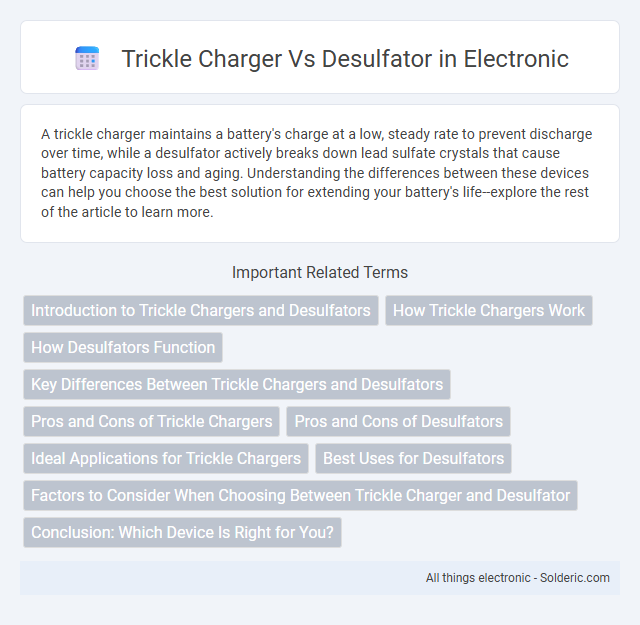A trickle charger maintains a battery's charge at a low, steady rate to prevent discharge over time, while a desulfator actively breaks down lead sulfate crystals that cause battery capacity loss and aging. Understanding the differences between these devices can help you choose the best solution for extending your battery's life--explore the rest of the article to learn more.
Comparison Table
| Feature | Trickle Charger | Desulfator |
|---|---|---|
| Primary Function | Maintains battery charge at a low, steady rate | Removes sulfate buildup on battery plates |
| Battery Type | Lead-acid, AGM, Gel | Primarily lead-acid batteries |
| Charging Method | Continuous low current charge | Pulsed high-frequency signals to break sulfate crystals |
| Usage | Battery maintenance during inactivity | Battery restoration and extending life |
| Effect on Battery Health | Prevents discharge and overcharging | Reverses sulfation damage |
| Cost | Generally lower | Typically higher due to technology |
| Installation | Simple plug-in | May require technical setup |
| Best For | Long-term battery upkeep | Reviving aged or sulfated batteries |
Introduction to Trickle Chargers and Desulfators
Trickle chargers maintain a battery's charge by providing a low, steady current that prevents self-discharge and extends battery life. Desulfators work by breaking down lead sulfate crystals that form on battery plates, restoring capacity and improving performance in sulfated batteries. Both devices serve distinct roles in battery maintenance: trickle chargers focus on ongoing charging, while desulfators address battery recovery and desulfation.
How Trickle Chargers Work
Trickle chargers work by delivering a low, steady current to maintain a battery's full charge without overcharging, ideal for long-term battery maintenance. They prevent self-discharge by compensating for natural power loss, ensuring your battery stays ready for use. Unlike desulfators, trickle chargers do not actively remove sulfate buildup from battery plates but focus on keeping the battery voltage stable.
How Desulfators Function
Desulfators function by sending high-frequency pulses to the battery plates to break down lead sulfate crystals that form during battery discharge, a process known as desulfation. This restoration helps recover lost battery capacity and extends battery life by improving the chemical reaction within the cells. Unlike trickle chargers that provide a steady low current to maintain charge, desulfators actively reverse sulfation damage to rejuvenate aging batteries.
Key Differences Between Trickle Chargers and Desulfators
Trickle chargers provide a continuous low-level charge to maintain your battery's full capacity, preventing self-discharge over long periods. Desulfators specifically target and break down sulfate crystals formed on battery plates, restoring efficiency and extending battery life. Choosing between these devices depends on whether you need ongoing maintenance charging or active battery rejuvenation.
Pros and Cons of Trickle Chargers
Trickle chargers slowly maintain your battery's charge, preventing it from discharging over time and extending battery life during periods of inactivity. They are simple to use, cost-effective, and ideal for seasonal vehicles, but can cause overcharging if not monitored properly, potentially damaging the battery. Unlike desulfators that focus on reversing lead sulfate buildup, trickle chargers primarily maintain charge without treating battery sulfation issues.
Pros and Cons of Desulfators
Desulfators effectively restore battery capacity by breaking down lead sulfate crystals, extending battery life and improving performance. However, they may not work on severely sulfated batteries and often require a longer treatment period compared to trickle chargers. Your choice depends on whether you prioritize immediate maintenance or long-term battery rehabilitation.
Ideal Applications for Trickle Chargers
Trickle chargers are ideal for maintaining the charge of vehicles or equipment that are stored for extended periods, such as classic cars, motorcycles, and lawn mowers, preventing battery drain without overcharging. These chargers deliver a low, steady current that compensates for battery self-discharge, ensuring your battery remains ready for use. Unlike desulfators, trickle chargers do not actively remove lead sulfate buildup, making them best suited for ongoing battery maintenance rather than restoration.
Best Uses for Desulfators
Desulfators are best used for restoring and maintaining lead-acid batteries suffering from sulfate crystal buildup, which extends battery life and improves performance. These devices effectively break down lead sulfate crystals that form during prolonged disuse or undercharging, making them ideal for older or deeply discharged batteries. Unlike trickle chargers that provide a slow, steady charge to maintain battery level, desulfators actively repair and rejuvenate battery capacity.
Factors to Consider When Choosing Between Trickle Charger and Desulfator
When choosing between a trickle charger and a desulfator, consider your battery's condition and maintenance needs: trickle chargers provide a steady, low current ideal for keeping fully charged batteries at optimal levels, while desulfators actively break down lead sulfate crystals to restore battery capacity. Battery type and usage patterns also play crucial roles, as desulfators are more effective for older or sulfated batteries, whereas trickle chargers suit regularly maintained batteries. Your decision should factor in charging speed, battery health restoration goals, and long-term performance requirements.
Conclusion: Which Device Is Right for You?
Choosing between a trickle charger and a desulfator depends on your battery's condition and maintenance needs; trickle chargers are ideal for keeping fully charged batteries topped up over long periods, preventing discharge without causing overcharging. Desulfators are designed to restore and extend the life of sulfated batteries by breaking down lead sulfate crystals, making them suitable for rejuvenating older or neglected batteries. Assess your battery's health and usage patterns to select the device that ensures optimal performance and longevity.
trickle charger vs desulfator Infographic

 solderic.com
solderic.com